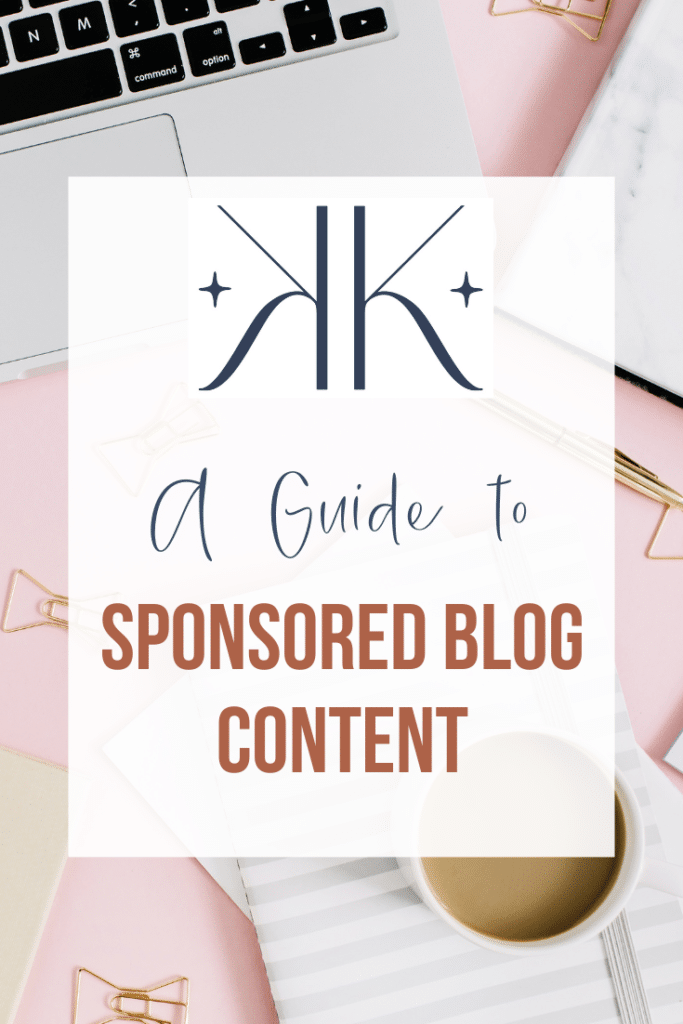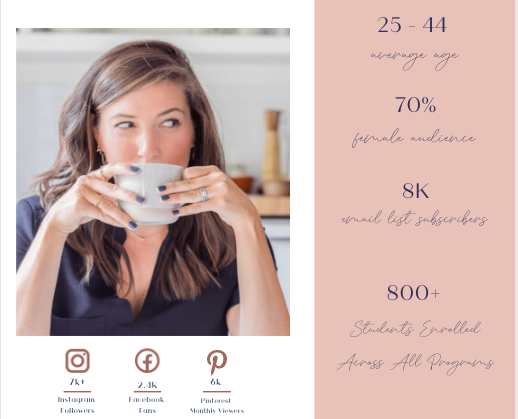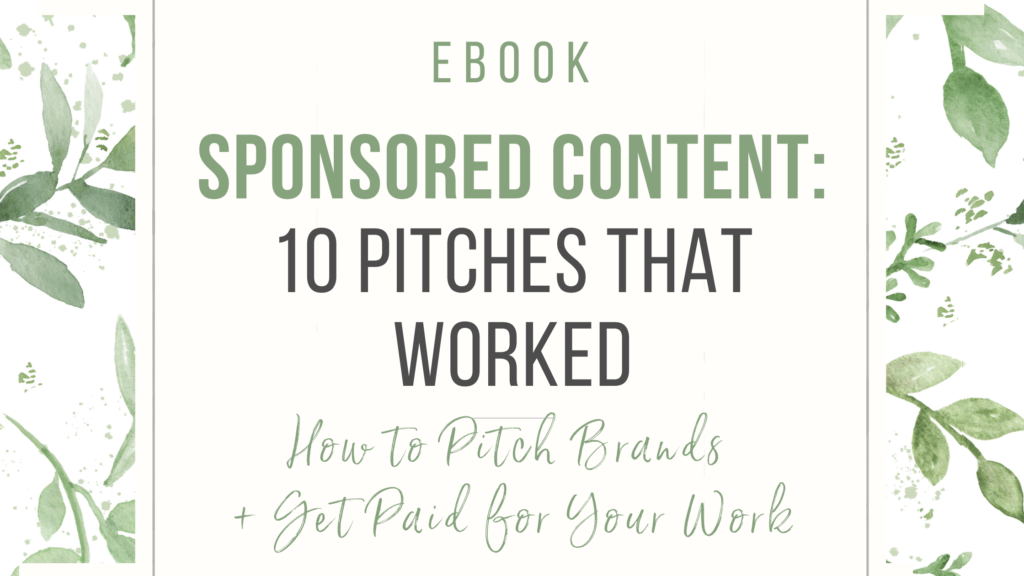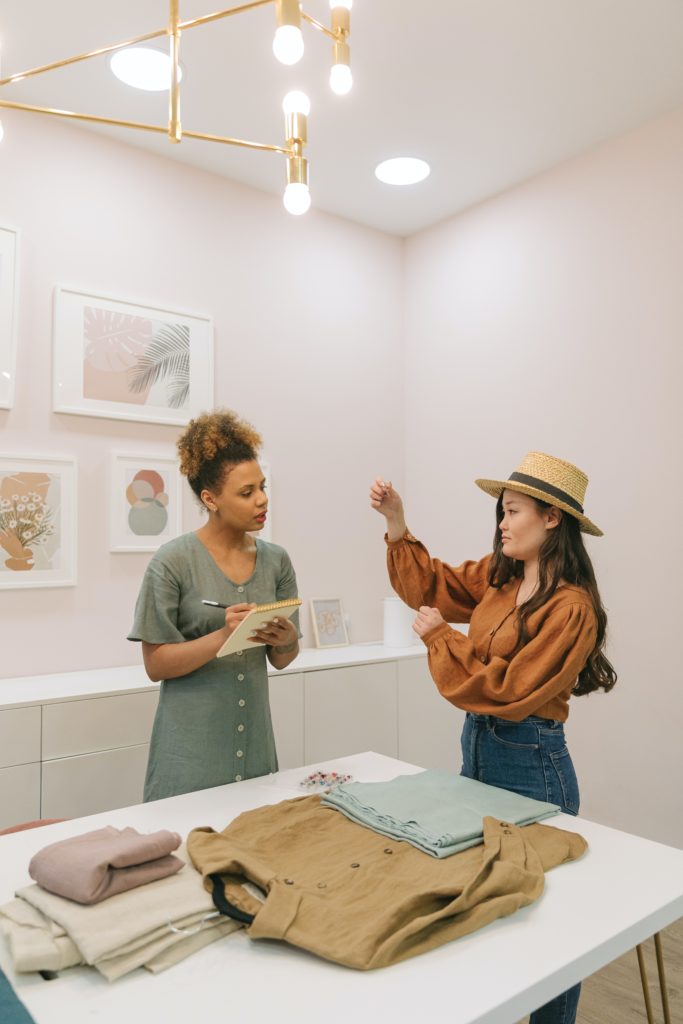Learn my secrets to creating a successful online business with my holistic strategies and soulful marketing advice for heart-centered entrepreneurs who value relationships, mindfulness, spirituality and health as much as strategic action and practical tips.
LEARN MORE →
Success with Soul Incubator
Success with Soul Shop
Launch Your Dream Offer Mini Course
Our most popular posts to help you create, grow and monetize your online business with soul!
EXPLORE POSTS →
Income Reports
Passive Income
Increasing Traffic
How to Get Sponsored in 2023: A Guide for Bloggers
July 29, 2018
Kate Kordsmeier
Hi, I’m Kate
Working mom, writer, educator and creative entrepreneur.
LEARN MORE →
Learn how to make money WITHOUT social media
free to join →
Explore a few of our favorite topics
INCREASING TRAFFIC
PASSIVE INCOME
INCOME REPORTS
Want weekly accountability + coaching?
Join our mastermind, The Room, the most powerful hour of your week. Clients who show up for these calls get better results faster—period. With weekly live coaching calls and monthly Get it Done Weeks, you'll actually (finally!) make progress in your business.
START FOR JUST $7 →
A holistic system for aspiring coaches, course creators + heart-centered entrepreneurs. Learn how to launch your business, launch your website and launch your offer(s), even if you have no idea where to start. Only $9!
READY FOR YOUR DREAM?
The Mindful Business Academy
Your All-Access Pass to a social-free, six-figure+ biz
LEARN MORE →
Last Updated on February 15, 2023
Learn how to get sponsored and produce branded content for your blog! In this guide to working with brands for bloggers, you’ll learn how I earned nearly $47,000 from sponsored content posts in one year of blogging, and how you, too, can increase your income by partnering with sponsors! We answer frequently asked questions from bloggers at all stages, plus reveal 6 steps you can take TODAY on how to pitch brands directly and make more money with branded content (even if you’re a new blogger!).

Table of Contents
If you want to learn how to get sponsored by creating content for brands or sponsors to increase your blog’s revenue, you’ve come to the right place.
After working with just a few brands in 2016, I knew that sponsored content posts would be my best bet at making money from blogging in 2017.
In fact, in 2016 I had just eight sponsored content campaigns, earning an average of $316.67 per blog post and $25 per Instagram post.
By 2017, I had completed 60 sponsored content campaigns + 8 Instagram-only posts, averaging $991 per blog post and $293.75 per Instagram post.
By June 2018, I was earning over $1,200 per sponsored content campaign, and brought in a total of $46,650 that year. In 2019, that number dropped to $25,250 because I no longer focused so heavily on sponsored content.
At the close of 2020, I totalled $19,300. Again, I haven’t relied so heavily on sponsored content, as I wanted to diversify my income and devote more of my energy on creating my own courses and programs. But my rates per post have increased significantly. I now charge $2,000+ per sponsored post!
So how did I do it? I share my tips on how to get sponsored in this post so that you, too, can start increasing your revenue and earning the income you deserve by working with brands!
A couple important things to note before we dive in:
I work really hard to only work with brands who are a perfect fit for my company –– this means that I often have to turn down requests from brands that don’t align with my mission and vision.
I could definitely make more money if I didn’t uphold those standards, but my first priority has always and will always be to my readers and so I’m very particular about what brands we feature.
On my old blog I was also publishing three times per week in 2017, so 52 branded content posts may sound like a lot, but it adds up to 1/3 of our content. If you only publish once a week, for example, then you clearly can’t aim to have 52 sponsors without every single post being paid.
Another thing to note: I haven’t focused as heavily on sponsored content lately, although I do have plans to increase my branded content in the future.
Alright –– let’s do this!

HOW TO GET SPONSORED TODAY: 6 TIPS
Even if you’ve been working with brands already, I’d say there’s a good chance that you’re working through an influencer network or some third party–am I correct? If so, you’re going to want to start with step #2 below, because you’re leaving a LOT of money on the table by not pitching brands directly.
Not only are you likely to earn FAR LESS through these third-party networks, you also usually have less say over the content, products, requirements, etc.
When you establish a direct relationship with a brand, it’s really a game changer; you can negotiate fees, requirements–anything you want! This means you can create content that’s more of a fit for your blog, all while making more of an income. Awesome, right?!
Admittedly, if you’re a brand-spankin’-new blogger with super low pageviews and a small social following, it’s not realistic to earn, say, $1,000 per post in the beginning.
But you can start somewhere, and even with a small following, you can absolutely land some gigs pretty soon after launching your blog for around $100-$200 per post. Here’s how!
1. JOIN INFLUENCER NETWORKS
Influencer networks connect brands who are looking for sponsored content with bloggers and influencers. Typically you apply to be part of the network and then proceed to apply for specific campaigns coming up in the pipeline. If chosen, you typically earn about $50-$500+ per post (depending on their requirements), which is super exciting, especially when you’re starting out!
This is the best way to initiate working with brands as, once you have a few pieces of sponsored content under your belt, you have some great examples to show other brands, and also get an idea of what this whole process is like, how long the work takes you, etc., so that you then have a better idea of how much you want to charge brands in the future.
Plus, you’re earning an income from your blog, which is just awesome!
Here are some common networks you can join (note that some have requirements, like length of time blog has been established, pageviews, social following, etc.):
- Social Fabric (By Collective Bias)
- Massive Sway (SITS Girls)
- Activate (By Bloglovin’)
- Acorn
- Blog Meets Brand
- Izea
- TapInfluence

2. CREATE A MEDIA KIT
Okay, the time has come to start pitching brands directly about partnering instead of/in addition to using the influencer networks. First, you’re going to want to create a media kit, which is usually a document that showcases who you are, your brand, your audience, stats, rates, etc.
Instead of a document, I opted to create a media kit website on Canva as a dedicated page, which I update quarterly. I like having a bigger, more professional piece of real estate to showcase the work that I’ve done vs. one piece of paper. This is, of course, not at all necessary, especially getting started. Keep it simple and just get a simple, clean PDF created. #progressoverperfection
Here’s a great article from Melyssa Griffin on all the details of how to create your media kit, and she even provides a template for you so you can just plug in your deets and be all set.
3. BRAINSTORM BRANDS
Now that that’s out of the way, it’s time to make a list of all the brands that would be a good fit for your blog.
For me, I’ve got to ensure that they align with my company mission of helping women drop hustle and build streamlined online businesses. Whatever your brand values are, you obviously have to make sure the brands are a great match as authenticity always wins over income.
An easy starting point would be writing down all the brands you already use and love. If you’re a food blogger, look in your pantry and fridge for ideas. Beauty blogger? Look in your makeup bag, shower, and bathroom. You get the idea!
For now, you’re just brain dumping and putting all of these brands into a spreadsheet (I like Google Docs).

4. FIND THE RIGHT CONTACT PERSON
In the second column of your spreadsheet, you need to find the contact information for each brand. This is an art, and can sometimes take time, but it’s definitely doable in almost all cases. I actually usually pitch 2-4 contacts per brand to make sure I reach someone, as you’ve really got to be proactive here. It’s important that, whenever possible, you’re emailing a direct person, not a generic address like support@[brand.com] or customerservice@[brand.com], as those emails are often black holes.
NOTE: The way I alleviate any annoyance a brand might feel about me emailing multiple people on their team (which has never actually happened, by the way), is by saying the following in the pitch after the greeting (see step #5 for more about the pitch):
“Apologies in advance for the mass email–I wasn’t sure who manages influencer relations for [BRAND], so please let me know the best contact moving forward.” That’s it!
Here’s the top four ways I go about finding the right contact:
- I start by going to the brand’s website and looking for their PR, press or media contact. Or someone in sales/advertising/marketing/social media. Sometimes it’s right on their contact page, sometimes it’s in FAQs, sometimes it’s on a press page or in a press release, etc.
- Download the Hunter extension. This is an icon you can click when you’re visiting any website, and it will give you a list of known email addresses for that company, as well as the typical email format for that company, e.g. first.last@companyname.com. So very cool! Sometimes if I can figure out a person’s name, I can use Hunter to determine the company’s email format and piece it together myself.
- If that doesn’t work, I head over to LinkedIn and look up the company, searching their employees for anyone with a title about marketing, social media, brand relations, etc. From there, I either use the email format suggested in Hunter, or I use a different tool called Contact Out, which gives you people’s email addresses from almost any LinkedIn profile with the click of an icon. It’s like magic.
- If all else fails, simply reach out to the brand on social media or in a chat if they have that functionality on their site and ask who the proper contact person is. This has also worked for me many times.

5. WRITE + EMAIL YOUR PITCH
Write a template that explains who you are, what’s special about your blog and what you can do for the brand by producing sponsored content for them. Tweak it to fit each individual brand so that your pitch is customized and on target. I recommend using YAMM, an incredible tool for sending emails in bulk that can actually be personalized for each recipient. Plus, you can track who receives, opens, and responds to your email!
I usually give a brief overview of the company, including a couple of impressive stats, along with praise for their brand and why I’m interested in a specific product of theirs and think it would be a good fit for the blog.
But moreso than giving them kudos for their work, I give them a reason to work with me. What benefit will they receive if they partner with me? How can I help them? This is KEY!
Then, I ask if they work with influencers on sponsored content and provide the link to my media kit. I end simply with a thanks and “I look forward to hearing from you.”
Once you have your pitch ready, email all of the brands on your list. (See FAQ below on a couple great tools to support you with this step.)
Not sure what to say in your pitch?
If you want EXACT copies of real pitches I sent to brands–that actually work and landed paid sponsorships–get our Sponsored Content: 10 Pitches That Worked e-book here! I share examples across different niches, plus some notes from me about why it worked, and the fee I earned for the campaign (which will give you an idea of what kind of money you can expect to make from sponsored content at different stages in your blog). If you actually follow through and use these templates, it’ll be the best money you ever spent as you’ll earn it back with just one sponsor!

6. FOLLOW UP
If you don’t hear back after 1-2 weeks, follow up. This is SO IMPORTANT! I can’t tell you how many gigs I’ve landed just from following up. People are busy, email inboxes are flooded with requests, things get lost in the shuffle and a friendly, professional follow up is a great way to land business.
Plus, using YAMM makes follow-up super easy, tracking in a spreadsheet when you sent your last follow-up, plus providing a way to keep track of who needs follow-up.
You’d be surprised how many people respond to emails #2 and #3, so be sure to not skip this part.

Sponsored Content FAQ
Ready for a quick lightning round Q&A? These are some of the most commonly asked questions I get from readers:
If you have a team or assistant, who should do the pitching?
I decided it was best to hire a business manager to start pitching relevant brands. Why? Two main reasons:
a) TIME: It’s time-consuming, and I really want to spend my time creating content and working on other important things to grow my business and brand–not so much the tedious work of finding the right contact person, responding to dozens of emails, etc.
b) AUTHORITY: I feel it helps a ton to have a third-party to pitch my business; I always felt a little strange pitching myself and I think it adds some professionalism and legitimacy to the business to have a liaison handling the campaigns.
How do you stay organized and track it all?
We have a MASSIVE spreadsheet in Google Docs where we make lists of potential sponsors, keep tabs on open conversations and track existing partnerships.
One of the biggest lifesavers has been YAMM, an email sending tool designed for mass emailing. You organize your contacts and any personalizations in a spreadsheet, and then send emails from the extension. Then you can track results and send follow-ups based on those.
For example, we send an initial round of pitches to let’s say 40 brands. If after 7 days we haven’t heard back from 25 of them, we use YAMM to send a follow-up email to those we need to connect with again.
Then, after 14 days, we send a final email reminding them about the opportunity, letting them know we’re assuming that they aren’t interested since we haven’t heard back. After three tries, I usually let it go, or look for new contacts if it’s a brand I really want to work with.
You can also use Boomerang, an amazing Gmail plugin productivity tool that allows you to set a time and/or date when you’d like the email to pop back into your inbox based on if you’ve received a reply, or after a certain amount of time has passed. You can also schedule emails to be sent later. It’s super handy and has many purposes–in this case, it’s great for setting reminders to follow up later if you decide not to use Mailshake.
How do I know how much to charge?
Sponsored blog posts are a ton of work–between managing the contracts and timelines, organizing and producing the photo shoots, writing the post, sharing on social, etc. it takes a lot of manpower to produce.
Then, there are several people I have to pay from my compensation–my assistant gets a commission on every deal she helps orchestrate, my photographer and video editor have to get paid, I have general operating expenses to cover, I gotta pay Uncle Sam and then whatever’s left is what I get to keep.
In 2017, I decided to charge $1,000 per sponsored blog post. Occasionally we’d give a discount on that number for brands we really wanted to work with but who couldn’t afford the rate, but rarely went below $750 (and often only gave a discount if they booked multiple posts as part of a package).
For 2018, once my pageviews and social audience increased drastically, I increased my rates to $1,500 per post or $5,500 for a package of four posts. (In fact, I now ONLY do the bundled packages and don’t do one-off posts–more on that below). We also charge an extra $1,000 per video.
Ultimately, I had to decide how much I wanted to make per each post, and what value I bring to the brands to ensure they’re getting a return on their investment. There’s a sweet spot where these two numbers can meet, where BOTH you and the brand feel like you’re getting a deal.
A good way to measure this is to calculate your average cost per engagement (CPE) to see how well your sponsored posts are performing. I really recommend everyone do this to get a sense of where you stand, what kind of posts do best for you and on what platforms, etc.
We keep really close track of the stats for our sponsored campaigns–currently, posts with videos have an average cost per engagement of $0.07 compared to $0.19 per engagement overall. Industry standard is $1 per engagement, so even without video, our posts still perform really well (but video definitely helps!).
Knowing how great our CPEs are really helps me confident in charging the prices that I do.
No one can tell you what to charge besides you. You know your costs, your goals and what feels good to you. If you’re stuck, just pick something and see how it feels when you’re in the process. Do you feel rewarded and excited, or did you end up feeling like you spent way more time and energy than it was worth? From there, you can tweak your rates going forward.
What are the pros and cons of sponsored content on social (vs. a blog post)?
I have recently taken steps to going social-media free in my business, or at least using organic social a lot less than I used to. You can read more about that decision here.
I used to think that I wanted to focus more on Instagram partnerships, rather than blog posts since those are less time-consuming and leave more space on the blog for non-sponsored content where I can write about whatever I want. With a rate of $500 per Instagram post, this seemed like a no-brainer.
However, what I’ve realized is that I really prefer to work with brands in a larger and longer-term capacity, which includes blog posts along with social posts for that brand. I find this helps streamline workflow, increases trusts with readers and is more authentic. Thus, here are my thoughts…
CON: If I was largely focused on social only sponsors, my social feeds would become more like a big billboard and less like a genuine feed, and I don’t want my feed filled with sponsors and ads all the time (talk about a surefire way to kill off engagement).
PRO: Social posts are SUPER easy and quicker than writing blog posts.
CON: Increasing brands on social means increasing the photo shoots I have to do, the follow up and tracking, etc. While you make some money–which is great!–you could also be putting your time into a larger package with a brand and ultimately earning more income, vs. a bunch of these one-off social posts.
PRO: Brands seem to love social right now, particularly Instagram, so you can make them happy and get paid at the same time by promoting something you love.
CON: You’re relying on one or two platforms for income, which could be gone tomorrow, and there’d be nothing you could do. Your blog is more under your control, and–assuming the entire world wide web doesn’t crash tomorrow forever–is a longer term strategy that simultaneously provides valuable content to your audience. With Instagram and Facebook’s ever-changing algorithms, engagement is impossible to predict and my reach has been significantly impacted, no matter what I do. I prefer having more control and being able to reach my followers whenever I want, like with blog posts and my email list.
How should I decide when a trade or product exchange is worth it? (vs. getting paid)
In the early days of blogging, it’s exciting to get free products, samples and subscriptions. After a while though, the glamour fades, your cabinets are bursting with junk you’ll never use and, honestly, it gets a little old.
In the past I haven’t done a ton of trade because I really wanted to get paid what I was worth and, as nice as it is to get packages of protein bars, salad dressing or beauty products, it’s not bringing in any income. While I’ve loosened up on this recently and tweaked my strategy (more on this below in the next section), I was pretty set against doing trade overall most of last year. Why?
‘Cause you can’t pay your mortgage with free supplements, food or cleaners.
So at a certain point you have to decide what’s more important to you: free product or actual money.
Even when I was more strict about this, there were still certain brands I loved that never had a budget, yet were happy to send product. Since those were products I would’ve actually spent money on anyway, I was fine to move forward with the trade because of my love for the brand and the fact that I’d at least save a little money on my grocery bill.
Another example of this was with a yoga studio here in Atlanta where I was regularly going to hot yoga (before I got pregnant). This was something I was happily paying money for each month, but I also wanted to do a story on my old blog about yoga.
So, I reached out to them and they gave me a 6-month unlimited pass in exchange for writing a blog post about them. While I didn’t get paid directly for it, in a sense I did because that’s $125/month that I would’ve spent out of pocket.
What’s important here is that we’re only working with brands we believe in and that fit our mission of organic, non-toxic and eco-friendly AND we never guarantee coverage as it’s not really a pay-for-play strategy. Rather, we would only accept free product from brands we’re pretty sure would be a fit and then we only recommend those brands we truly love.
It’s a win-win as it’s much more cost-effective for brands to send product than to pay $$, plus if you’re in need of the product (and/or would spend your own money on it anyway) , it’s a great way to really research and test out dozens of products.
So should you do product trade or monetary compensation?
In sum: The answer to this question will likely be different for every brand and campaign, but it’s something important to consider and make a choice based on your current needs and goals.
How often should I pitch to brands each month? And how much should I post to the blog each month?
This varies depending on how many brands we pitched. We’d go through rounds of reaching out to a lot of brands in different categories (let’s say 20 each in beauty, food, etc.) and from there, we would do about 4 sponsored posts/month in addition to social media only posts that were totally separate.
Download a copy of our spreadsheet to use in your own biz here!

Why I Cut Back on Sponsored Content + How My Strategy Has Changed
As many of you noted in your comments on my annual income report for 2017, a HUGE bulk of my income in the last years came from sponsored posts ($53,882.50 to be exact, which was over 70% of my income). This really scared me, as I don’t like to ever have one source be that high. It could go away tomorrow and then what?
Plus, with sponsored content, you’re trading time for dollars, meaning it’s not scalable. It’s time-consuming, versus other more passive streams like affiliate marketing and product creation.
Thus, I spent a lot of January 2018 backing off from sponsored content and putting that time into more scalable projects, like affiliates, my email list, and my own products. Our affiliate efforts really paid off–in just 5 months, we increased our affiliate marketing revenue by 380%, and I couldn’t be happier. You can read more about affiliate marketing here!
Another big change in working with brands is that I only took clients who booked a bundle of 4 posts minimum (except in rare cases or for occasional social-only posts, as shared above). It’s so great to minimize the number of brands I’m working with to just those who are great and easy to work with, perfectly in line with my mission, provide me with repeat work and help me plan in advance.
For example, our edit calendar was completely booked through December 2018, totaling $40,000 in sponsored content for the year.
This worked SO well for us, both in terms of revenue and workflow, and I plan to keep this strategy moving into 2019.
Whew! I know that was a lot, but I hope it helped give you clarity, confidence and inspiration on taking action when working with brands for your blog. Good luck!
Questions? Leave ’em in the comments below and I’ll do my best to answer them!
And remember: you don’t need to reinvent the wheel! Get REAL copies of pitches I sent to brands–that actually work and landed paid sponsorships–with our Sponsored Content: 10 Pitches That Worked e-book here!
This post may contain affiliate links. Read about our privacy policy.

Just Between Us 
There are juicy deals and insider-only offers that I share only with my email community. If you love a good behind-the-scenes peek, let’s make it official and get you on the Whole Soul List, a sacred pause for heart-centered, ambitious entrepreneurs. See what it's truly like to unsubscribe from the status quo and create a life and business on your terms.
IT'S MORE THAN A LIST; IT'S A MOVEMENT!
Leave a Reply Cancel reply
Where are you in your business?
I don't have a biz yet + don't know where to start, but know I'm meant for more!
SOUNDS LIKE ME! →
I'm busy and overwhelmed, desperate for work-life balance
Yes! Tell me more →
I have an online business and want to sustainably scale without social media.
I’m so ready for this →

FEELING OVERWHELMED?
There’s only one way to eat an elephant (hint: one bite at a time!) and our 30-step roadmap to starting an online business will help you check things off your to do list like a pro!
YES, PLEASE!
JOIN US ON SLACK
Join our client/student-only, social-media-free VIP Soul Circle on Slack to connect with other heart-centered entrepreneurs on the path to success with soul!
JOIN OUR COMMUNITY →
EVERYTHING
about
THE SHOP
AFFILIATE PROGRAM
resources
the blog
THE podcast
Your New Sunday Ritual: the Whole Soul List newsletter
COPYRIGHT © 2024 • SUCCESS WITH SOUL LLC
Subscribe →
We are an LGBTQIA-affirming, interfaith-oriented, diverse organization. We are committed to social and environmental justice, including civil rights, dismantling systems of oppression like the Patriarchy, White Supremacy and Diet Culture. We believe Black Lives Matter.
login



This is incredible and truly inspiring! I love your story and how you ramped up your sponsorships so quickly and yet authentically–that can be a hard balance to strike, but you’ve done it!!
Thank you Sarah!
Hi, I tried to download your sponsored content tracking google doc but it didnt work when I put my email in. Are you able to email me another link?
Hi, Julie: Which part didn’t work? It looks like you received an email with a link to download the Google doc…what happened when you clicked that link? I’m sorry for any trouble, feel free to email me directly at kate@rootandrevel.com and we’ll get you taken care of!
I love this article! Thanks, Kate! I have a question: How do you set a calendar to keep you on track with sponsored posts? Do you do it on a spreadsheet?
Thanks again!
Awesome – glad you enjoyed! Yes, I use a spreadsheet for everything! (You can download it in this post) We have our entire editorial calendar set for the year and work a couple months in advance, so always know what we need to work on next. I have photo shoots every 2 weeks, so can see what’s coming up and what needs to be prepped for that. Hope that helps!
I tried to download it and after I type in all my info, it just says error!
Hi Ashlee – we’ll email you now with instructions
How often each month were you pitching to brands would you say? You mentioned 40 was that each month? And how many were you posting to the blog each month? This is so helpful and encouraging! I have a very specific niche so I find it a bit difficult to Always find a ton of brands!
It really varied on how many brands we pitched; we’d go through rounds of reaching out to lots of brands in different categories (say 20 each in beauty, food, etc.) and usually were doing about 4 sponsored posts/month in addition to social media only posts that were totally separate. Glad this has been helpful for you and good luck!
LOVED this! Exaclty what I needed… my questions is how do you turn around an offer for free product into a paid sponsorship? Do you just send your media kit with prices? Thank you! This was so so so helpful
Really glad you found this helpful! Yes, exactly. You can say something like, “Thank you for sharing about X! I’d love to learn more about BRAND’S NAME as it sounds like it could be a great fit. Do you ever work with influencers on sponsored content? If so, I’ve attached my media kit. Once you have a chance to review it, I’d be happy to send over some story ideas and/or answer any questions about how we can partner! Hope to work with you soon.”
Thank you for the helpful info, however the google doc took me to a baby registry checklist. Question- how would you negotiate with a brand that says they will only offer free product because they’re a small business? Do I say I’m only accepting payment and see if they come in with an offer? If they just send free product am I obligated to write a whole post about their product or is that just out of generosity? f there’s no money exchanging hands, am I not bound to write anything? Thanks!!
Sorry about that Marissa – we just switched email providers so had some kinks to iron out. It should be working now, or email us to get the doc if you’d like! To answer your questions, it really depends on the brand. Sometimes they just don’t have a budget and there’s no space for negotiation, while other times they have some wiggle room.
Whether or not you decide to only get paid for your work vs. getting free product again depends on you and your strategy. I did that for a while when I really wanted to increase my income and it worked well, but now I tend to enjoy free samples and products I’m genuinely interested in instead of doing sponsored content, simply because I like having freedom in what I write about and am happy with where my income is at, so it’s just not necessary at this stage for me. You can try your idea about saying you’re only accepting payment and see how it goes!
Finally–no, you are not obliged to write a whole post in exchange for product, you just need to be SUPER CLEAR up front. For a really high value trade it might be a different story, but for $20 worth of salad dressings (for example) I just make it clear that I will sample the products and consider them for editorial inclusion if I love the product. Whew, hope all that helped!